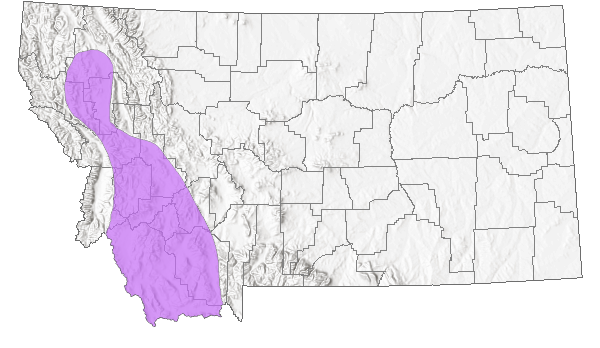View in other NatureServe Network Field Guides
NatureServe
Montana
Utah
Wyoming
Idaho
Wisconsin
British Columbia
South Carolina
Yukon
California
New York
Threetip Sagebrush - Artemisia tripartita ssp. tripartita
Native Species
Global Rank:
G5T5
State Rank:
S4
C-value:
Agency Status
USFWS:
USFS:
BLM:
External Links
General Description
PLANTS: Well-developed shrubs of 5–80 cm height with fibrous roots and adventitious buds that can sprout after fire (FNA 2006; Lesica et al. 2012). Plants are pale gray to gray-green and densely tomentose and aromatic (Lesica et al. 2012).
LEAVES: 1–3 cm long and deeply divided into linear or linear-oblong segments divided distally into 3 linear lobes.
INFLORESCENCE: Paniculate. Bracts that subtend the flowers are linear and entire.
Our plants are subspecies tripartita. Montana’s report of Artemisia tripartita ssp. rupicola is based on a MONT specimen (accession 56976) that was mislabelled and was actually collected in Wyoming. Subspecies rupicola is only known from Wyoming (FNA 2006).
Phenology
Subspecies tripartita flowers mid- summer to late fall (FNA 2006).
Diagnostic Characteristics
Subspecies tripartita is a taller shrub (when compared to subspecies rupicola) ranging from 20-80 cm in height. Leaf lobes are linear and less than or equal to 0.7 mm width (ssp. rupicola leaf lobes are 1-1.5 mm wide).
Species Range
Montana Range
Range Descriptions

 Native
Native
Range Comments
BC to MT, south to OR, NV, UT and WY (Kartesz 2009).
Observations in Montana Natural Heritage Program Database
Number of Observations: 23
(Click on the following maps and charts to see full sized version)
Map Help and Descriptions
Relative Density

Recency



 (Observations spanning multiple months or years are excluded from time charts)
(Observations spanning multiple months or years are excluded from time charts)
Habitat
Subspecies tripartita lives in sandy to clay soils of sagebrush steppe; valleys to subalpine (Lesica 2012 et al.). Deep loam soils, usually igneous in origin and at elevations from 900 to 1900 meters (FNA 2006).
Ecology
Sagebrush in general is adapted to climates with cold winters where most precipitation falls in the winter (Meyer 2008). Shrubs in the genus Artemisia are important winter browse for ungulates (Meyer 2008). This species relies on wind for pollination and seed dispersal (Meyer 2008). Each seed is enclosed in a papery pericarp. The pericarp has mucilaginous nerves that may help the seed stick to the soil while its root penetrates (Meyer 2008).
Subspecies tripartita may be one of the parents involved in the presumed hybrid origin of Artemisia arbuscula ssp. thermopola.
Reproductive Characteristics
Artemisia tripartita ssp. tripartita flowering heads are in paniculiform or spiciform arrays of (5-)8-15(-35) cm by 0.5-1.0 cm (FNA 2006). The involucre is turbinate, 1.5-3 mm wide and 2.5–3.5 mm tall; the outer phyllaries are green and canescent while the inner phyllaries are brown to purple and glandular (Lesica et al 2012). The receptacle is glabrous. Heads are comprised of 3 to 11 disk flowers that are perfect, glandular, and have yellow to reddish corollas of 1.5–2 mm length (Lesica et al. 2012). Achenes are glabrous or resinous and about 2 mm long (Lesica et al. 2012).
Management
In the Snake River and Columbia River basins, much of the habitat for subspecies tripartita has been lost to farming, and some populations occur as isolated islands along drainages and at the bases of mountain slopes (FNA 2006).
Stewardship Responsibility
References
- Literature Cited AboveLegend:
 View Online Publication
View Online Publication Flora of North America Editorial Committee. 2006. Flora of North America North of Mexico. Vol. 19. Magnoliophyta: Asteridae, part 6: Asteraceae, part 1. Oxford Univ. Press, New York. xxiv + 579 pp.
Flora of North America Editorial Committee. 2006. Flora of North America North of Mexico. Vol. 19. Magnoliophyta: Asteridae, part 6: Asteraceae, part 1. Oxford Univ. Press, New York. xxiv + 579 pp. Flora of North America Editorial Committee. 2006. Flora of North America North of Mexico. Vol. 20. Magnoliophyta: Asteridae, part 7: Asteraceae, part 2. Oxford Univ. Press, New York. xxii + 666 pp.
Flora of North America Editorial Committee. 2006. Flora of North America North of Mexico. Vol. 20. Magnoliophyta: Asteridae, part 7: Asteraceae, part 2. Oxford Univ. Press, New York. xxii + 666 pp. Lesica, P., M.T. Lavin, and P.F. Stickney. 2012. Manual of Montana Vascular Plants. Fort Worth, TX: BRIT Press. viii + 771 p.
Lesica, P., M.T. Lavin, and P.F. Stickney. 2012. Manual of Montana Vascular Plants. Fort Worth, TX: BRIT Press. viii + 771 p. Meyer, S.E. 2008. Artemisia L. in Bonner, F.T. and R.P. Karrfalt. The Woody Plant Seed Manual. Agric. Handbook No. 727. Washington, DC: USDA, Forest Service. 1223 p.
Meyer, S.E. 2008. Artemisia L. in Bonner, F.T. and R.P. Karrfalt. The Woody Plant Seed Manual. Agric. Handbook No. 727. Washington, DC: USDA, Forest Service. 1223 p.
- Additional ReferencesLegend:
 View Online Publication
View Online Publication
Do you know of a citation we're missing? Hoffman, T.L. 1996. An ecological investigation of mountain big sagebrush in the Gardiner Basin. M.Sc. Thesis. Bozeman, MT: Montana State University. 84 p.
Hoffman, T.L. 1996. An ecological investigation of mountain big sagebrush in the Gardiner Basin. M.Sc. Thesis. Bozeman, MT: Montana State University. 84 p. Johnson, J.R. 1966. The effects of some environmental influences on big sagebrush, Artemisia tridentata Nutt., reinvasion. M.Sc. Thesis. Bozeman, MT: Montana State University. 100 pp.
Johnson, J.R. 1966. The effects of some environmental influences on big sagebrush, Artemisia tridentata Nutt., reinvasion. M.Sc. Thesis. Bozeman, MT: Montana State University. 100 pp. Lesica, P., M.T. Lavin, and P.F. Stickney. 2022. Manual of Montana Vascular Plants, Second Edition. Fort Worth, TX: BRIT Press. viii + 779 p.
Lesica, P., M.T. Lavin, and P.F. Stickney. 2022. Manual of Montana Vascular Plants, Second Edition. Fort Worth, TX: BRIT Press. viii + 779 p.
- Web Search Engines for Articles on "Threetip Sagebrush"





